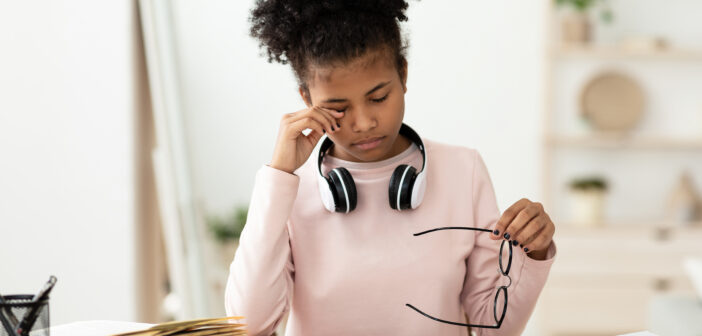Like many parents across New Jersey, my husband and I decided to have our children learn remotely. I thought I went over all the academic, health, and social ramifications of remote learning, but there was one that I didn’t think about—their eyes. My 9-year-old daughter began to complain of repeated headaches about a month into this school year. The bouts only came on when she was on her tablet for school and not while playing video games. I didn’t dismiss her complaints, but I monitored her closely. Then, I noticed she wasn’t able to read words when she was close to the screen.
I chucked bad parenting guilt right out the window and made an appointment to have her see an optometrist. After several tests, she was diagnosed with mild hyperopia, otherwise known as farsightedness. Since she never had any eye issues before (she receives a yearly exam at our pediatrician), I immediately suspected her digital devices as the culprit. The optometrist instructed her to take her eyes off the screen every 20 minutes and gave her a prescription for glasses to wear during virtual school. But she and her brother used tablets even outside of school time. So we declared that Sundays from now are “tablet-free” to help alleviate all the time spent on screen.
Shortly after picking up my daughter’s new My Little Pony specs, I learned about an NJMOM Live Facebook chat hosted by my friend and fellow NJMom squadmate Marisa Brahney. She spoke with Dr. Neda Gioia, O.D., founder of Integrative Vision in Shrewsbury, who gave great advice on protecting and maintaining kids’ eyes with all this screentime. Here’s my takeaway from what she said:
Watch your kid’s eye positioning while on the screen. Take note if they frequently look away from the screen, squint, cover an eye, blink hard, or tilt their head. If your child complains of headaches as my daughter did, it may be time for an eye exam. But there are a few things you can do to alleviate eye strain. First, look at the device’s position—it should be eye level or 10 degrees below eye level, never above. The screen should also be 16 inches away from your child’s face. And talk to your kids about taking brief screen breaks every 20-30 minutes. To get your kids in the habit of looking up, make a target at the farthest point in the room (it can be a picture or something that they love) and have your child look at it for a minute before going back to the screen. Also, remind them they should blink every so often—staring at a screen without frequent blinking may cause dry eye.
Load up on veggies because proper nutrition helps keep your eyes healthy. You may know about the benefits of carrots for eyes, but leafy greens have lutein and zeaxanthin, both of which play a unique role in eye health. Not only can they help reduce disability and discomfort from glare, enhance contrast, and increase visual range, they can even help prevent age-related eye diseases like macular degeneration. You can also have your kids take supplements if they are picky eaters and don’t get enough vegetables.
Limit additional screen time, especially before bed. Blue light is part of the light spectrum from infrared to ultraviolet light. LCD screens emit a substantial amount of blue light, which can be concerning with all this increased screen time. Dr. Gioia says while there is no proven permanent damage to the retina from blue light, we don’t know much about the effects of excessive, up-close use of digital devices yet. If you’re worried, Dr. Gioia suggests downloading a light-controlling app like f.lux, which regulates the amount of blue light emission from screens. Blue-light blocking screens and glasses are an option too, but the jury is still out on how effective they are. Still, they can reduce glare and brightness, which can help alleviate eyestrain. But most importantly, blue light blocks the release of melatonin (the hormone that regulates sleep), so it’s best to turn off devices at least half an hour before bed.
Go outside for a real eye break. Studies show that as little as one extra hour of outdoor time per week could reduce the chance of nearsightedness by as much two percent. Plus, spending time outside helps kids get the ‘good’ blue light from the sun during the day, improving alertness and their moods—and gives everyone a break from the Google Classroom.
I’m glad that I was proactive with identifying and acting when I noticed something awry with my daughter. She’s been wearing her glasses and taking breaks from the screen. But that’s not the only change—I thought my kids were going to rebel when we announced “no tablet” Sundays. To our surprise, they saw it as a challenge on how they can have fun without their devices. Fortunately, we’re all seeing the big picture a little clearer these days.










